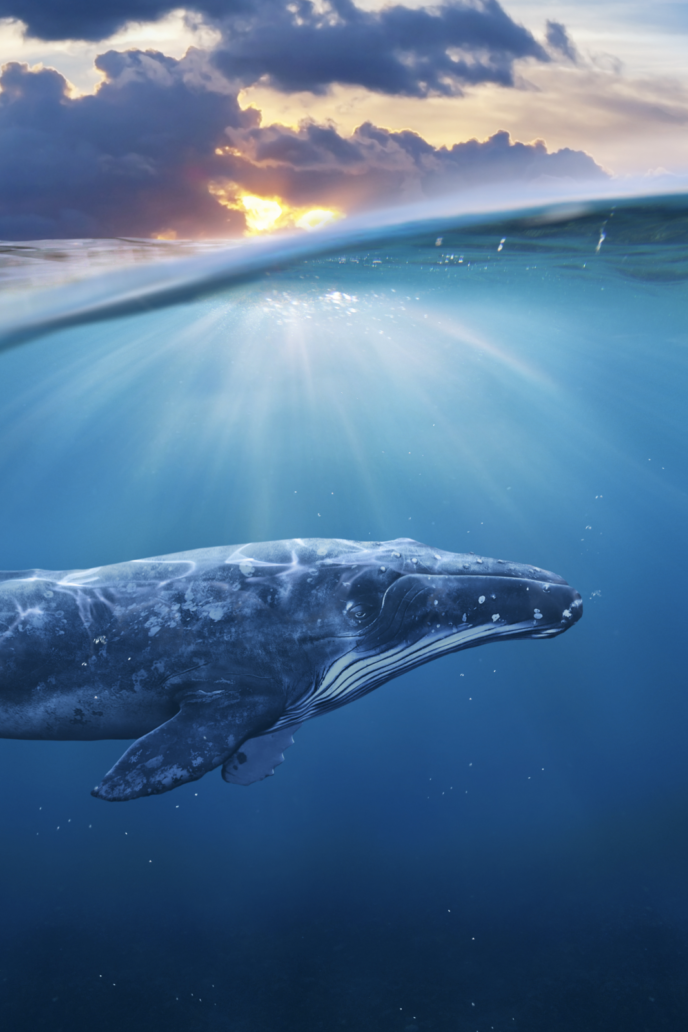Hawaiian waters serve as a haven for several species of whales, each possessing its own unique characteristics and behavioral patterns. Among the most renowned are the majestic Humpback whales, who migrate to Hawaii’s warm waters annually for breeding. Additionally, other species such as the Sperm whale, Pygmy killer whale, and rare False killer whale add to the rich marine biodiversity of the Hawaiian waters. This article delves into the fascinating world of these magnificent creatures, exploring their behaviors, habitats, and the roles they play in Hawaii’s ecosystem.
7 Types of Whale in Hawaii
1. Humpback Whales
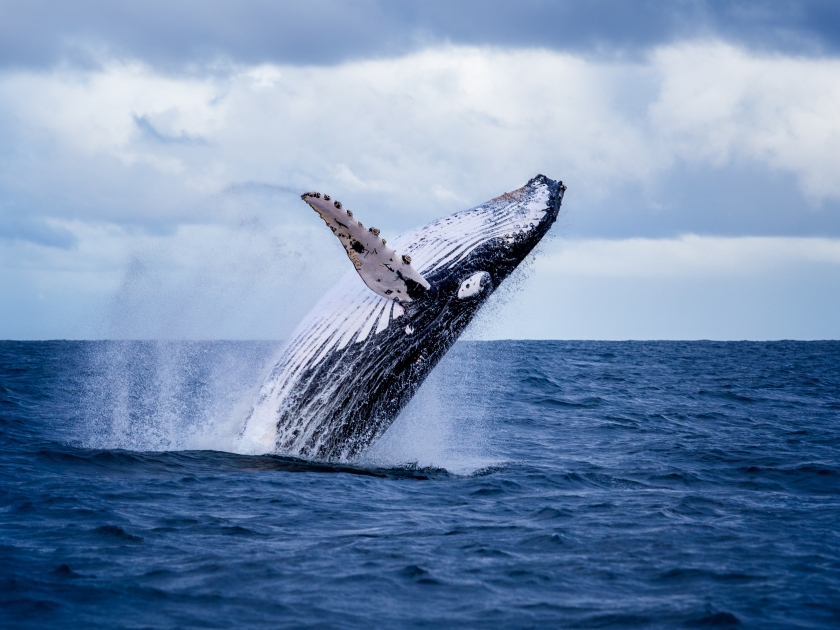
Morphology
Humpback whales are known for their unique physical features. They are large creatures, reaching lengths up to 60 feet, and weigh approximately 40 tons. Their bodies are primarily black or dark grey with a white underside. The most distinctive feature is the humpback’s long, wing-like pectoral fins, which can span up to a third of their body length.
Notable Locations
The Hawaiian Islands are one of the main winter breeding grounds for the North Pacific humpback whale population. Prime locations include the waters around Maui, the Big Island, and Oahu, where guided tours provide optimal opportunities for observing these marine giants.
Annual Migration and Breeding
The best times for humpback whale watching in Hawaii typically align with their migration season, which spans from December to April, peaking in February. This annual migration, one of the longest of any mammal, is driven by the need for warm waters for birthing and raising calves.
Behaviors in Hawaiian Waters
These majestic creatures exhibit a range of behaviors in Hawaiian waters. They are known for their acrobatic displays, such as breaching and tail slapping. Mother humpbacks are also seen guiding and protecting their young calves.
Population Status and Conservation Efforts
While the humpback whale was once a threatened species, conservation efforts have seen their numbers increase significantly. Today, the North Pacific population is estimated to be over 20,000. Hawaiian waters, now a Hawaiian Islands Humpback Whale National Marine Sanctuary, play a vital role in these conservation efforts.
2. False Killer Whales
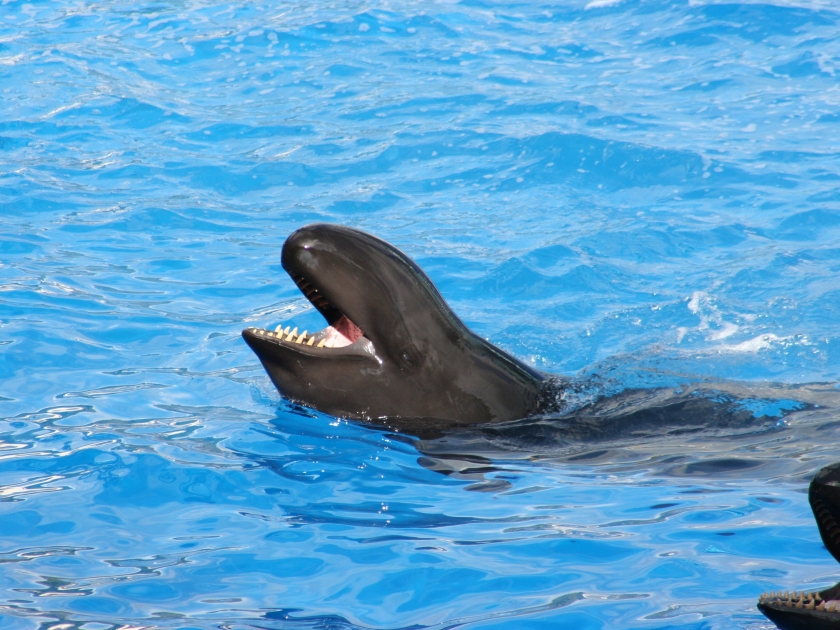
Morphology
False killer whales, despite their name, are not closely related to killer whales. They can grow up to 20 feet long and weigh up to 1.5 tons. Their bodies are predominantly black or dark gray, sleek and torpedo-shaped, with a prominent dorsal fin and long, slender pectoral fins.
Notable Locations
False killer whales are found in tropical and temperate waters worldwide, including around the Hawaiian Islands. They are often spotted in the warm open waters, but also closer to shore, especially near the Island of Oahu.
Annual Migration and Breeding
Unlike humpback whales, false killer whales are not migratory and are seen in Hawaiian waters year-round. Their presence is not tied to a specific migration season, offering enthusiasts the opportunity to encounter these remarkable marine mammals throughout the year. Although their breeding habits are not fully understood, it is known that they have a slow reproduction rate, which makes them vulnerable to population decline.
Behaviors in Hawaiian Waters
Known for their strong social bonds, these whales frequently travel in pods and are known to share their prey. They are also known for their acrobatic displays, including breaching and slapping the water with their tails.
Population Status and Conservation Efforts
False killer whales are listed as endangered under the U.S. Endangered Species Act, primarily due to threats like incidental capture in fishing gear. The current population is estimated to be less than 200 individuals. Conservation efforts include regulation and modification of fishing practices, and research to better understand their population trends and biology.
3. Melon-headed Whales
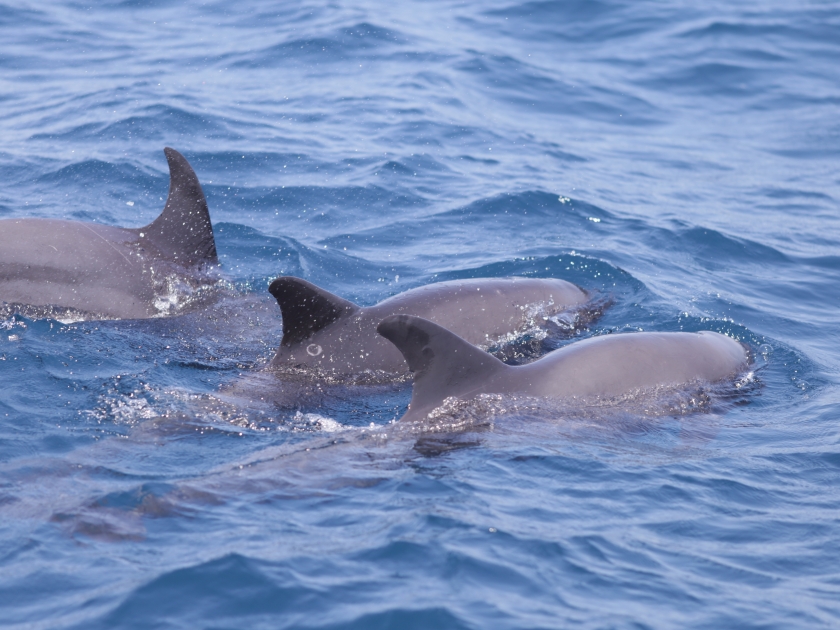
Morphology
Melon-headed whales, also known as “Electra dolphins,” are small members of the dolphin family, typically measuring up to 9 feet in length and weighing around 460 pounds. They have a distinctive conical head shape, which gives them their name, and a slim, streamlined body. They are typically dark gray with a lighter underbelly.
Notable Locations
These marine mammals are found in deep waters throughout the tropical and subtropical regions of the world. In Hawaii, they are most frequently spotted in the waters around the main Hawaiian Islands, particularly between the islands of Kauai and Niihau.
Annual Migration and Breeding
Unlike humpback whales, melon-headed whales do not undertake long annual migrations and are present in Hawaiian waters year-round. They breed throughout the year, with no specific breeding season.
Behaviors in Hawaiian Waters
Melon-headed whales are highly social animals, often seen in large groups of several hundred members. They are fast swimmers and are known for their playful behavior, frequently seen leaping and riding swells.
Population Status and Conservation Efforts
The exact number of melon-headed whales is unknown, but their population is believed to be stable and not currently threatened. They are protected by the Marine Mammal Protection Act, and efforts are made to reduce potential threats, such as noise pollution and entanglement in fishing gear.
4. Short-finned Pilot Whales
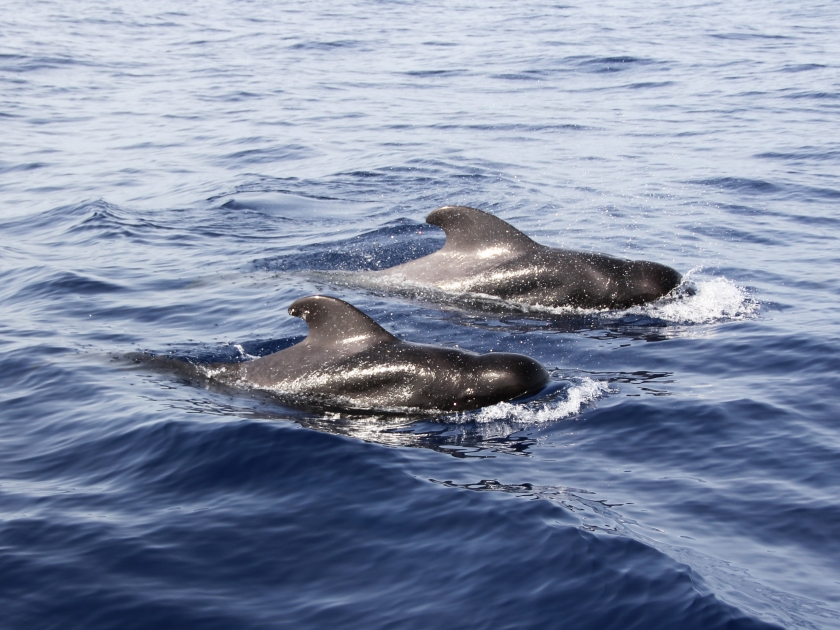
Morphology
Known for their bulbous foreheads and short, slender bodies, Short-finned Pilot Whales are one of the larger members of the dolphin family weighing up to 6600 pounds. Males can reach lengths of up to 24 feet, while females are slightly smaller. This species’ distinguishing feature is a pair of short pectoral fins, just behind the head. Their color varies from dark grey to black.
Notable Locations
They are a tropical species and in Hawaii, they tend to cluster around the island of Kauai and off the leeward side of the Island of Hawaii. They are the most frequently spotted whale species in these areas.
Annual Migration and Breeding
Unlike other whale species, Short-finned Pilot Whales do not have a specific migration pattern. They are known to stay in Hawaiian waters all year round. Breeding can occur at any time but is most common in the spring and summer.
Behaviors in Hawaiian Waters
Short-finned Pilot Whales are social animals, living in pods of 15 to 50 individuals. They are known for their acrobatic behaviors, often breaching and slapping their fins on the water surface. They are also known to ride the bow wave created by boats, which makes them quite a sight for tourists.
Population Status and Conservation Efforts
While the exact population of Short-finned Pilot Whales is not known, they are not currently considered endangered. However, they are vulnerable to threats such as bycatch and noise pollution. In Hawaii, there are regulations in place to prevent harassment by boats and to protect their habitat.
5. Orcas
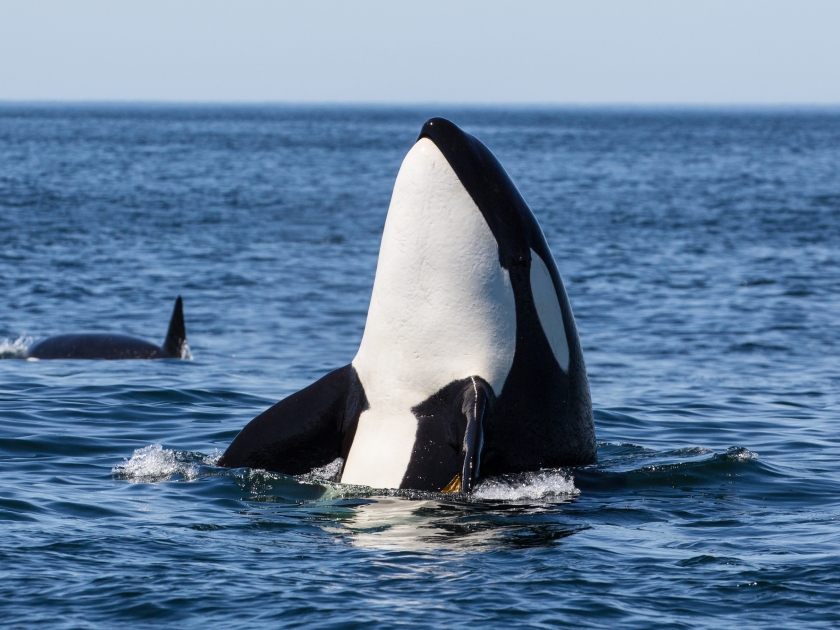
Morphology
Orcas, also known as Killer Whales, stand out with their striking black bodies contrasted with white patches, including a distinctive white eye patch. They can reach lengths of up to 32 feet and weigh as much as 11 tons. Known as the largest species of the dolphin family, their dorsal fins are particularly noticeable, towering up to six feet in height in males.
Notable Locations
While not as prevalent as the humpback, Orcas have been spotted in Hawaiian waters. For enthusiasts seeking opportunities to observe orcas in Hawaii, offshore deep waters are often the preferred locations. While sightings are less frequent compared to other cetacean species, the waters surrounding the islands of Maui, Kauai, and the Big Island are known hotspots where guided boat tours may increase the chances of a rare encounter.
Annual Migration and Breeding
Orcas do not have a definitive migration pattern in Hawaiian waters, and sightings can occur throughout the year. They are not known to breed or live in Hawaiian waters.
Behaviors in Hawaiian Waters
Orcas are recognized for their intelligence, hunting prowess, and complex social structures. In Hawaiian waters, they have been observed hunting large prey such as sharks.
Population Status and Conservation Efforts
The global Orca population is large and widespread, with estimates ranging from 50,000 to 100,000. However, certain populations are considered threatened or endangered due to factors such as habitat disturbance, pollution, and declining prey availability. Conservation efforts are largely focused on reducing these threats and protecting their marine habitats. In Hawaii, incidental sightings of Orcas contribute to our understanding of these enigmatic marine mammals.
6. Sperm Whales
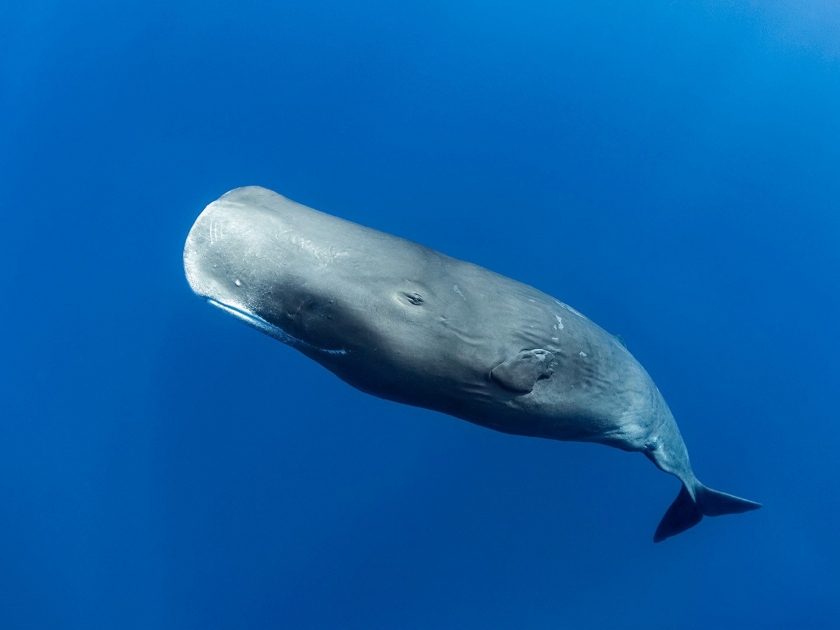
Morphology
Sperm whales are easily recognizable due to their distinctive body shape. Male sperm whales can grow up to 36 feet in length and weigh up to 80 tons, while females are considerably smaller. They have a block-shaped head, which constitutes about one-third of their body length, and a single blowhole located on the left side of the head’s front.
Notable Locations
Sperm whales can be found in both deep offshore and continental slope waters around Hawaii. They are often seen off the Kona Coast, where deep waters are accessible close to the shore.
Annual Migration and Breeding
Unlike other whale species, sperm whales do not follow a set migration pattern. They are present in Hawaiian waters year-round, but sightings peak from December through April. Females and young males live together in pods, while mature males are often solitary or travel in small groups.
Behaviors in Hawaiian Waters
Sperm whales are known for their deep dives to hunt, capable of staying underwater for up to an hour. They often display tail-slapping and fluking behaviors when they descend for a deep dive. They are not known for breaching like humpbacks, but they occasionally ‘lobtail,’ slapping the water with their tail flukes.
Population Status and Conservation Efforts
Sperm whales are a globally distributed species, and while not as numerous as humpbacks, they are not considered endangered. However, they face threats from entanglement in fishing gear, ship strikes, and noise pollution. Conservation efforts focus on reducing these threats and maintaining the health of the oceans they inhabit.
7. Blainville and Cuvier’s Beaked Whales
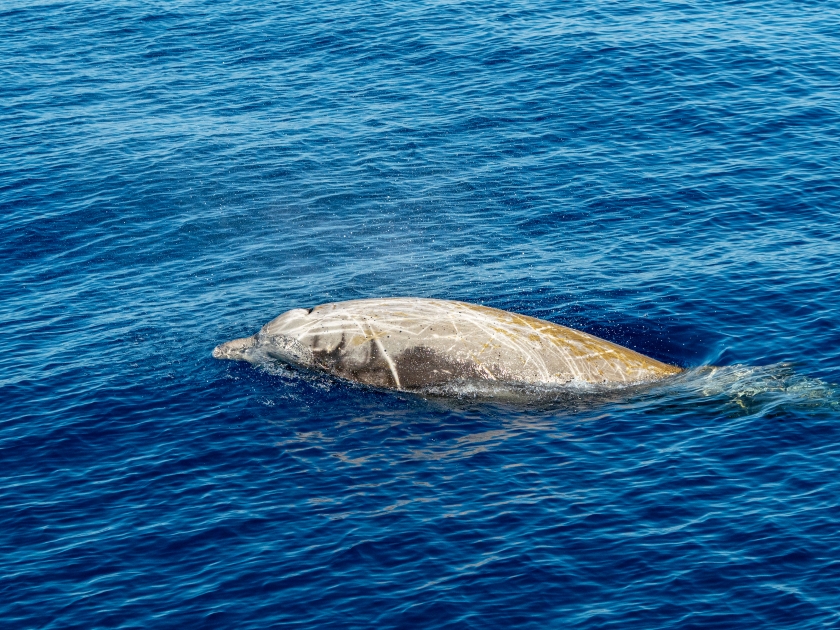
Morphology
Both Blainville and Cuvier’s beaked whales are toothed whales with a distinctive beak-like snout. The Blainville’s beaked whale typically measures up to 15 feet and weighs 2,200 pounds, characterized by a curved dorsal fin and dark-blue gray body. Cuvier’s beaked whales, larger than their Blainville counterparts, can reach over 23 feet and weigh up to 5,500 pounds. Their body is gray with white or pink patches.
Notable Locations
The deep waters off the coast of the Hawaiian Islands are known to be inhabited by these beaked whales, especially the channels between the islands. Sightings are less frequent compared to more common whale species, but guided boat excursions in areas around the islands of Maui and the Big Island may provide a unique and immersive experience.
Annual Migration and Breeding
While not much is known about the migratory patterns of these beaked whales due to their elusive nature, breeding appears to occur throughout the year. Females give birth to a single calf every two to three years.
Behaviors in Hawaiian Waters
These species are known for their deep diving behavior, often reaching depths over 1,000 meters, where they feed on squid and deep-sea fish. They are relatively solitary and are rarely seen in large groups.
Population Status and Conservation Efforts
The population status of both species in Hawaiian waters remains unknown due to their deep-sea habits and elusive nature. Current conservation efforts focus on mitigating human-induced threats, such as noise pollution from sonar and military exercises, which can cause stranding and death.
The Importance of Whale Conservation in Hawaii
The importance of whale conservation in Hawaii cannot be overstated. Whales contribute significantly to marine biodiversity, serving as vital indicators of the health of our oceans. Their migratory patterns and feeding behaviors influence the distribution of nutrients in the water, promoting primary production and supporting a variety of marine life. In Hawaii, the presence of these majestic creatures also brings socio-economic benefits. Whale watching is a major attraction for tourists, contributing significantly to the local economy. However, threats such as marine pollution, fishing gear entanglements, and climate change put these marine giants at risk, necessitating concerted conservation efforts. The establishment of the Hawaiian Islands Humpback Whale National Marine Sanctuary is a substantial step towards protecting these majestic creatures and their habitats. However continuous efforts to combat these threats and promote sustainable tourism practices are crucial to ensuring the survival of whale populations in Hawaiian waters.
Bask in the Magnificence of Hawaii’s Whale Species
The diverse array of whale species found in the Hawaiian waters truly is a sight to behold. Each unique species adds to the rich tapestry of marine life that makes these islands a paradise for whale watchers and marine enthusiasts alike. The whales of Hawaii, each with their own distinctive characteristics, migration patterns, and cultural significance, play a profound role in the ecosystem and the local mythology. Embrace the opportunity to witness the awe-inspiring beauty of Hawaii’s whales while fostering a sense of responsibility toward the protection of these extraordinary creatures and their oceanic environment.




